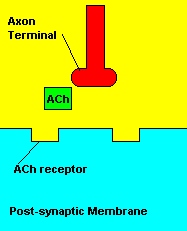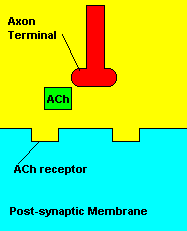For my post on poisons (Std. 2, sci. research) I decided to write about one of the most famous chemical weapons of all time, Sarin. Basically, Sarin is a human made chemical agent classified as a "Chemical Nerve Agent". Very deadly. It was developed in Germany in 1938 as a organophosphate pesticide. It was later sidcovered that it made a better chemicla weapon. It is classified as a Schedule 1 Nerve Gas, 500 times a deadly as cyanide. It is typically found as a colorless oderless liquid, but can evapotate a gas and spread into the enviorment.
Sarin works as a potent inhibitor of the enzyme cholinesterase. Sarin acts on cholinesterase by forming a covalent bond with the serine residue at the active site. With the enzyme inhibited, acetylcholine builds up in the synapse and continues to act so that any nerve impulses are stuck transmitting. Normally, the acetylcholinesterase (Jeez that a big word, AChE) breaks down the acetylcholine (ACh) in the synaptic cleft in order to allow the effected muscle or organ to relax. I found some pretty cool graphics on the second site which illustrate the process of ACh getting broken down by AChE in the normal one, and the the effects of Sarin in the poisoned one.
 |
- ACh is released at the axon terminal.
- ACh crosses the synaptic cleft.
- ACh binds with a receptor on the post-synaptic membrane.
- AChE (E) stops the action of ACh
|
Poisoned
 |
- ACh is released at the axon terminal.
- ACh crosses the synaptic cleft.
- ACh binds with a receptor on the post-synaptic membrane.
- Sarin (NA) blocks the ability of AChE to stop the action of ACh.
- ACh continues to work and more ACh builds up in the synapse.
|
Sarin affects all synapses that use acetylcholine as a neurotransmitter, which means both the central and peripheral nervous systems are affected. The affects of Sarin include: Twitching,Weakness, Paralysis, Respiratory failure, Reduced Vision, Small pupil size, Drooling, Sweating, Diarrhea, Nausea, Abdominal pain, Vomiting, Headache, Convulsions, Coma, Respiratory arrest, Confusion, Slurred speech, Depression, Respiratory depression. Immediate treatment is mandatory for people who have have directly ingested Sarin. Atropine is the most popular antidote for all kinds of nerve poisoning. Atropine works by blocking the receptors so the ACh in the synapse cannot work. No antidote works directly on Sarin.
So basically. Sarin. Its some bad stuff. Don't touch it. Don't mess with it. You might die. Dieing is bad. I think that sums it all up.
I used a few different sites for this post. First: http://www.bt.cdc.gov/agent/sarin/basics/facts.asp which is the article this post is reviewing, then http://faculty.washington.edu/chudler/weap.html and
http://en.wikipedia.org/wiki/Sarin for some more facts on Sarin.


No comments:
Post a Comment